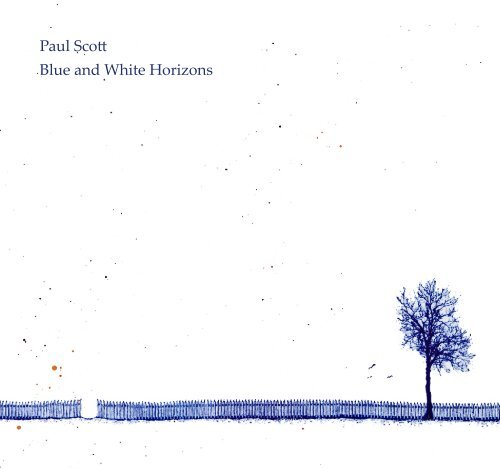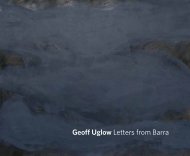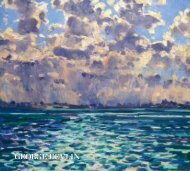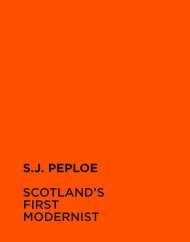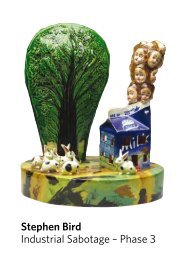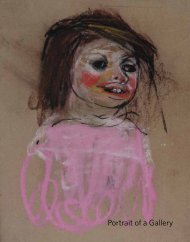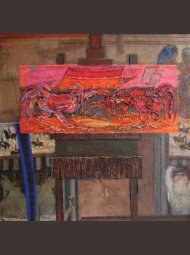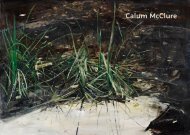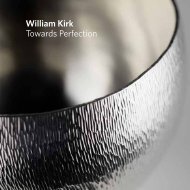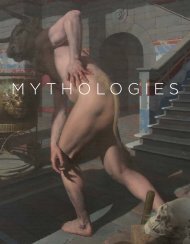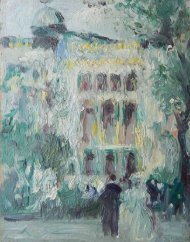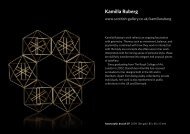Paul Scott Blue and White Horizons - The Scottish Gallery
Paul Scott Blue and White Horizons - The Scottish Gallery
Paul Scott Blue and White Horizons - The Scottish Gallery
- No tags were found...
You also want an ePaper? Increase the reach of your titles
YUMPU automatically turns print PDFs into web optimized ePapers that Google loves.
<strong>Paul</strong> <strong>Scott</strong><strong>Blue</strong> <strong>and</strong> <strong>White</strong> <strong>Horizons</strong>
<strong>Paul</strong> <strong>Scott</strong><strong>Blue</strong> <strong>and</strong> <strong>White</strong> <strong>Horizons</strong>1 - 24 December 2012Front cover: <strong>Scott</strong>’s Cumbrian <strong>Blue</strong>(s) <strong>The</strong> Fence Series, 2012, 30 x 30 x 1.5 cmsLeft: <strong>Scott</strong>’s Cumbrian <strong>Blue</strong>(s) Dumfries Tree. In-glaze decal on h<strong>and</strong> built tin glazedearthenware form
<strong>Paul</strong> <strong>Scott</strong>, born 1953, lives <strong>and</strong> works in rural Cumbria. He has been a professional artist for over twenty fiveyears. His research activity has meant an irregular but ongoing association with Universities, Research Centres,Museums <strong>and</strong> Art Galleries in a variety of contexts. <strong>Paul</strong> makes artwork for exhibition <strong>and</strong> to commission,whilst also juggling residencies, writing, curating, teaching <strong>and</strong> other projects. In 2010 he was awarded PhD byManchester Metropolitan University <strong>and</strong> in August 2011, took up a post as Professor 2 at Oslo National Academyof the Arts (KHiO) Norway.“<strong>Paul</strong> <strong>Scott</strong> works at his own political stance in the ceramics he produces. His work unfolds slowly. <strong>The</strong>re issomething beguilingly disarming about his traditional blue <strong>and</strong> white ware with which he works; something thatwrong-foots us. By choosing to work with industrially produced blue <strong>and</strong> white ware he has elected to underminethe cosiness, the decorative conceit that these ware can represent. But the commentary he makes is necessarilymore complex. <strong>The</strong> history <strong>and</strong> the origins of blue <strong>and</strong> white wares cannot be ignored, nor can the current stateof its production. Taking the traditional blue <strong>and</strong> white plate as his starting point <strong>Scott</strong> has manipulated it to giveit his own political charge. <strong>Scott</strong> chooses his canvas carefully. <strong>The</strong> imagery of ruralism sits there on the blue <strong>and</strong>white plates <strong>and</strong>, just like the Lake District itself, it blanks out the low flying jets, the slag heaps, the threat ofnuclear fallout <strong>and</strong> the dangers of foot <strong>and</strong> mouth disease. To this <strong>Scott</strong> adds imagery or erases parts of it. <strong>The</strong>seacute alterations <strong>and</strong> additions are the backbone of his work.” Ceramic Review, Issue 244 July/August 2010Work in Public Collections include:Victoria <strong>and</strong> Albert Museum, LondonNational Museum of Art Architecture <strong>and</strong> Design, OsloMuseum of Art <strong>and</strong> Design New York<strong>The</strong> Potteries Museum, Stoke on TrentStatens Konstråd (National Public Art Council, Sweden)Shipley Art <strong>Gallery</strong>, GatesheadDanish Arts Foundation, CopenhagenNordenfjeldske Kunstinustrimuseum (National Museum Decorative Arts) Trondheim, NorwayManchester City Art <strong>Gallery</strong>Museum Bellerive, Collection of Decorative Arts, ZurichNational Museum, Stockholm Sweden,Museum Ariana Geneva Switzerl<strong>and</strong>York City Museum <strong>and</strong> Art <strong>Gallery</strong>Tullie House, Carlisle Museum <strong>and</strong> Art <strong>Gallery</strong>
<strong>Scott</strong>’s Cumbrian <strong>Blue</strong>(s) L<strong>and</strong>scape with Fence <strong>and</strong> Wind Turbine, 2012, 23 diameter x 3.5 cms(Danish earthenware plate)
<strong>Scott</strong>’s Cumbrian <strong>Blue</strong>(s) L<strong>and</strong>scape with Wind Turbine, 2012, 23 diameter x 3.5 cms (Danish earthenware plate)
<strong>Scott</strong>’s Cumbrian <strong>Blue</strong>(s) L<strong>and</strong>scape with Wind Turbines 1. In glaze decal collage <strong>and</strong> gold lustre on oldDanish earthenwaer plate (c. 1930) marked Lone. 33 x 23.5 cms
Above: <strong>Scott</strong>’s Cumbrian <strong>Blue</strong>(s) Vindsäter Tree, 2009 31.2 x 29 x 8 cmsRight: <strong>Scott</strong>’s Cumbrian <strong>Blue</strong>(s) Vindsäter Figures 2009 overall dimensions approx 42 x 22 x 14 cms (4 parts)
<strong>Scott</strong>’s Cumbrian <strong>Blue</strong>(s) Vindsäter Tree 2, 2012, 32 x 23 x 3.6 cms (Danish earthenware plate)
<strong>Scott</strong>’s Cumbrian <strong>Blue</strong>(s) <strong>The</strong> Fence Series, 2012, 30 x 30 x 1.5 cms
Willow after Bernard LeachLeach wrote:‘Patterns may be described as concepts of decorationreduced to their utmost simplicity <strong>and</strong> significance. <strong>The</strong>yare analogous to melodies in music <strong>and</strong> proverbs inliterature. <strong>The</strong>ir significance is enhanced by directness ofpersonal statement <strong>and</strong> detracted from by mechanicalreproduction, for in such reproductions continuous vitalinterpretation is lacking, however good the original. That iswhy well painted pots have a beauty of expression greaterthan pottery decorated with engraved transfers, stencils orrubber stamps.’1<strong>The</strong> remediated object Willow after Bernard Leach lays bare the paucity of Leach’s distain for theprinted graphic. It is the reaction of stain with fire, ash <strong>and</strong> glaze that imbues the melodious <strong>and</strong>proverbial - not necessarily the h<strong>and</strong> painted, but Leach’s philosophical attachment to the h<strong>and</strong>made <strong>and</strong> oriental aesthetic makes him an unsuited commentator on the industrial heritage ofceramics. He has been thrust into this space by his role as the father of the studio pottery movementwhich until recently claimed a strangle hold on the contemporary dialogue within British ceramics.His thinking on printed ceramics probably deserve to hold as much influence as mine on the craftpottery movement.<strong>Paul</strong> <strong>Scott</strong>, October 20121. Leach, Bernard (1940) A Potters Book p. 101, Faber <strong>and</strong> Faber (1967 edition), LondonRight: <strong>Scott</strong>’s Cumbrian <strong>Blue</strong>(s) Willow, After Bernard Leach, 20 x 20 x 1 cm, screenprint, wood, salt firedtile, made at Kecskemét Hungary in 2009
<strong>Scott</strong>’s Cumbrian <strong>Blue</strong>(s) Spode Tree, 2010, 29.5 x 17.5 x 5.5 cms, h<strong>and</strong>built form with direct screenprint,wood (soda) fired Guldagergård (Denmark) 2010.
<strong>Scott</strong>’s Cumbrian <strong>Blue</strong>(s) Afetr the By-Pass (wild Rose). In glaze decal collage <strong>and</strong> gold lustre on oldearthenware plate (c. 1850). 26 cm dia.
<strong>Scott</strong>’s Cumbrian <strong>Blue</strong>(s) Hedgerow No:6, In glaze decal collage <strong>and</strong> gold lustreon old earthenware plate (c.1930) marked Copel<strong>and</strong> Late Spode. 38 x 28 cms
<strong>Scott</strong>’s Cumbrian <strong>Blue</strong>(s) Willow Tray with Birds 2009/2012, Spode bone china tray <strong>and</strong> 2 Willow patterntree porcelain cups , h<strong>and</strong>-thrown porcelain forms (by Ann Linnemann). In-glaze decals <strong>and</strong> gold lustre.Cups: 10 x 8.7 cms.Plate: 36 x 17 x 2.3 cms.
Cumbrian <strong>Blue</strong>(s) <strong>and</strong> Anne LinnemannThis body of work features industrially sourced pattern <strong>and</strong> image on AnnLinnemann’s h<strong>and</strong> thrown, porcelain forms - some juxtaposed with antiquetableware. I buy old, sometimes patterned, plates on e-bay, in junk <strong>and</strong> antiqueshops, <strong>and</strong> these live with me - often for months or years. Some stay with mein my studio, whilst others make it into the house where they are used forserving food. When the time comes, I add to them – a mark, a line, a goldedge, or I compose - collaging with in-glaze decals. <strong>The</strong>n I re-fire them togive them a new life. <strong>The</strong> collaboration with Linnemann has been ongoingfor a number of years, <strong>and</strong> although we both use techniques that are suited torepeat <strong>and</strong> batch production, the prints <strong>and</strong> objects are very strictly limitedin number. Our interest is to develop <strong>and</strong> explore an evolving relationshipbetween print <strong>and</strong> tableware forms, telling stories <strong>and</strong> making unexpectedconnections.<strong>Scott</strong>'s Cumbrian <strong>Blue</strong>(s) Tree in a Garden. In-glaze decals <strong>and</strong> gold lustre on aporcelain cup by Ann Linnemann on an old (c 1920) earthenware tray markedJewil T.R. And Co. Tray 20cm x 16cm, cup 7cm tall.
Spode Works ClosedIn July 2009, I was given permission to visit the closed Spode Works in Stoke. Whilst there I was allowed tocollect <strong>and</strong> take away a small quantity of ab<strong>and</strong>oned tableware. I also took photographs of the derelict site. Itwas a sad poignant experience. I well remember the site as a thriving working factory <strong>and</strong> recall my meetingsover the years - with Robert Copel<strong>and</strong>, <strong>Paul</strong> Drakaway <strong>and</strong> Trevor Drurose in the engraving department as Iresearched my book Ceramics <strong>and</strong> Print, then doing my own research (funded by the Arts Council) to investigateindustrial print archives - at the Spode Museum Trust with Pam Wooliscroft. I recall the ‘connoisseurtour’, buying white-ware <strong>and</strong> seconds to work on. Although these research periods in Spode were relativelyfleeting - they were memorable. After the visit in July 2009 I made a series of artworks from the collectedtableware. Many of the found plates were covered with unknown dried substances (presumably once liquids),some were mouldy <strong>and</strong> others simply dusty. I began to explore how I could use these industrial remnants, atfirst simply firing the coated pieces to see what happened. Some of them disintegrated in the kiln into razorsharp shards. In others the dust or mould simply vanished, burnt away in the kiln, but on some forms the dustparticles - maybe glaze or ceramic pigments, rust fallen from factory roof beams, or copper from electricalfittings - have fused in the glaze, vitrified evidence of ab<strong>and</strong>onment. Some plain bone china plates were cleanedup <strong>and</strong> used as the vehicle for a series of in-glaze screen-prints depicting the factory in its death throws.At the dawning of the age of print media Spode’s innovative printed l<strong>and</strong>scape patterns on ceramics createdan iconic ceramic genre. Its decline in the new era of digital media is characteristic of our age - not restrictedto Stoke on Trent, but replicated in many towns <strong>and</strong> cities across Britain, Europe <strong>and</strong> North America. SpodeWorks Closed is a commemorative for Spode, <strong>and</strong> for the wider loss of manufacturing, skills <strong>and</strong> knowledgewhich continue to haemorrhage away.<strong>Scott</strong>’s Cumbrian <strong>Blue</strong>(s) Spode Closed Casserole, 2009/12, In glaze decals <strong>and</strong> gold on a small Spodecasserole, 30 x 23 cms
Caroline Slotte is well known for her telling interventions into the graphic surfaces of decorativeindustrial tablewares. Her delicate physical editing of image <strong>and</strong> pattern create serene, miniaturepoetic l<strong>and</strong>scapes on a domestic scale. <strong>The</strong>y invite us to peer <strong>and</strong> journey into new confected worlds.In the process of creating her new l<strong>and</strong>scapes, she discards material unsuited to the compositionat h<strong>and</strong>. In 2011 I acquired several of her edited plates destined for the trash. I thought they had apeculiar kind of beauty, but their raw edges <strong>and</strong> paper stickers required further working. <strong>The</strong>y spentseveral months sitting in my studio, looking at me. I had several email conversations with Carolineherself who assented to my re-working of these particular forms. This Willow bowl is one of theresults of this artistic conversation.Right: <strong>Scott</strong>’s Cumbrian <strong>Blue</strong>(s) Ting Tang Upcycled Slotte Trash No:1, Willow. Gold lustre <strong>and</strong>in-glaze decals on cut Arabia Willow Pattern bowl, 24cm dia., trashed by Caroline Slotte 2010
A Willow for Ai Weiwei (Wen Tao, Liu Zhenggang, Zhang Ginseng <strong>and</strong> Hu Mingfen) 2011, 45.3 x 26 x 5.2 cms.Conceived whilst the artist was was in detention. It commemorates his disappearance, <strong>and</strong> the continuingharassment of his friends <strong>and</strong> colleagues.
A Willow for Ai WeiweiChinese artist Ai Weiwei was detained by plainclothes police officers at Beijing airport on 3 April 2011. He washooded before being put in a car <strong>and</strong> driven to secret locations where he was held until his release on June 22.For a time ‘two officers watched him round the clock. He was not allowed to speak <strong>and</strong> had to requestpermission to drink water <strong>and</strong> use the toilet. When Ai told police their actions were illegal, officers replied:"Do you know before Liu Shaoqi died, he was holding the constitution?... Talk about illegality, there's no differencebetween the country that we are in now <strong>and</strong> the time of the Cultural Revolution." Liu was one of China'stop leaders but was purged <strong>and</strong> died during the brutal political turmoil which Mao Zedong unleashed in the1960s.....Even on the day of his release, officers reminded Ai he could still face 10 years in jail for inciting subversionto state power – a vaguely-worded charge often used against dissidents – a source said. He had to agree toconditions including no media interviews, no meetings with foreigners, no use of the internet <strong>and</strong> no interactionwith human rights advocates for one year from his return home. Ai has given few details of his detention,beyond saying that he experienced "extreme conditions", <strong>and</strong> says he is not able to give interviews.He appears to have been held by the Chinese authorities because of his practice as a contemporary visual artist.As well as campaigning for more openness in Chinese society, through his work Ai Weiwei has also been responsiblefor a growing awareness in the West of the richness of Chinese art, history <strong>and</strong> culture.<strong>The</strong> Willow Pattern was designed in Stoke on Trent in the early part of the nineteenth century. It was looselybased on imported Chinese porcelain with painted l<strong>and</strong>scapes. It is the most commonly produced printedceramic pattern ever made, <strong>and</strong> is familiar to millions the world over. Weiwei too has become an international#phenomena through his artworks <strong>and</strong> installations. <strong>The</strong> original makers mark is joined by <strong>Scott</strong>’s Cumbrian<strong>Blue</strong>(s) <strong>and</strong> Real Art stamps which are signature marks on all my artworks. <strong>The</strong> Willow plate by an unknownfactory is probably nearly nearly 200 years old <strong>and</strong> was purchased on ebay in 2011.<strong>Paul</strong> <strong>Scott</strong> October 2012
<strong>Scott</strong>’s Cumbrian <strong>Blue</strong>(s) Three Gorges After the Dam 3, In glaze decal collage <strong>and</strong> gold lustre on partiallyerased antique Willow pattern platter (c.1840), 36 x 29 cms
<strong>Scott</strong>’s Cumbrian <strong>Blue</strong>(s) Fukushima, In glaze decal collage <strong>and</strong> gold lustre onpartially erased, cracked Willow pattern platter, marked Ocean, Sakakibara, Japan, 48 x 36 cms
<strong>Scott</strong>’s Cumbrian <strong>Blue</strong>(s) Seascale Pigeon No. 14, In glaze decal collage <strong>and</strong> gold lustre on oldearthenware platter (c.1930), marked Bristol Poutney <strong>and</strong> Co. 40 x 33 cms
<strong>Scott</strong>’s Cumbrian <strong>Blue</strong>(s) Sellafield No:10, 2007, 30.5 x 22 x 2.5 cms(Made on old restaurant ware, during a residency at Emily Carr University in Vancouver)
<strong>Scott</strong>’s Cumbrian <strong>Blue</strong>(s) Beznau. Inglaze decal collage <strong>and</strong> gold lustre on old earthenware plate (c.1930)marked marked Reliable, Phoenix, Burslem. 36cm x 26cm
On Cracks, Blooms <strong>and</strong> ChipsContemporary attitudes to the re-use of existent material are generally verypositive - re-cycling wood for example in contemporary furniture has becomecommonplace, <strong>and</strong> the patina of age a pre-requisite for selling much'Country Living' type craft. If it does seem to be less acceptable with chipped,cracked or crazed ceramics then I'm not exactly sure why - perhaps itsbecause Antiques Road Show valuers frown upon them. However, I habituallycollect glazed tableware - from e-bay, junk <strong>and</strong> antique shops. Some of itmay have crazed glazing, some may be cracked, chipped, or the gold lustreworn from the edges. At first I was reluctant to use these pieces in work forsale, being aware that they are seen by some as flaws <strong>and</strong> devaluations, butover time I have grown very fond of these imperfections - I realized that it isbecause they evidence the object’s history. For me these characteristics areno longer flaws or reasons to reject the form - in fact quite the opposite - theyallude to the object's previous life, it has already been used <strong>and</strong> h<strong>and</strong>led, italready has a history. For me this evidence of wear is an enhancement to apiece. When re-working the ready made I usually acknowledge <strong>and</strong> bringattention to the mark, chip or crack. If it is on the rim of a plate or the lip of ajug I will fill in with lustre so it is quite obvious. Crazed glaze <strong>and</strong> dirty cracksoften fuse in the kiln with unexpected results within the glaze - I usually reallylike these - a bloom of grey or or pink on a plate or bowl adds to theirrichness. <strong>The</strong>se uncontrollable marks <strong>and</strong> fissures also often allude to theconceptual reasoning behind certain works.
<strong>Scott</strong>’s Cumbrian <strong>Blue</strong>(s) Muleberg, In glaze decal collage <strong>and</strong> gold lustre on old earthenware plate(c. 1930) marked Bristol Poutney <strong>and</strong> Co. 22 x 28 cms
<strong>Scott</strong>’s Cumbrian <strong>Blue</strong>(s) Seascale Pigeon No 12., In glaze decal collage <strong>and</strong> gold lustre on oldearthenware plate (c. 1920), 26 x 22 cmsBack cover (left to right):Soda Flowers i, 10.5 x 9.5 x 1.5 cms. Soda Flowers ii, 13 x 13.5 x 1.5 cmsSoda Flowers iii, 11.5 x 11.5 x 1.5 cms


